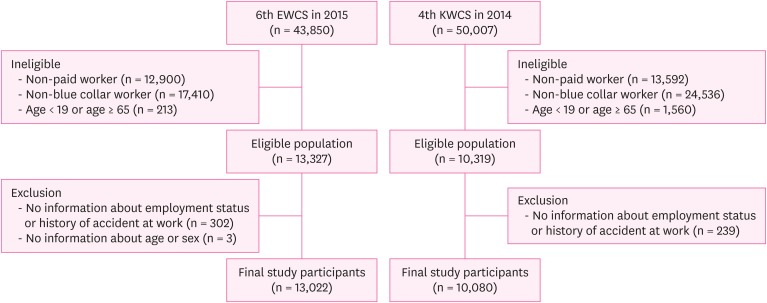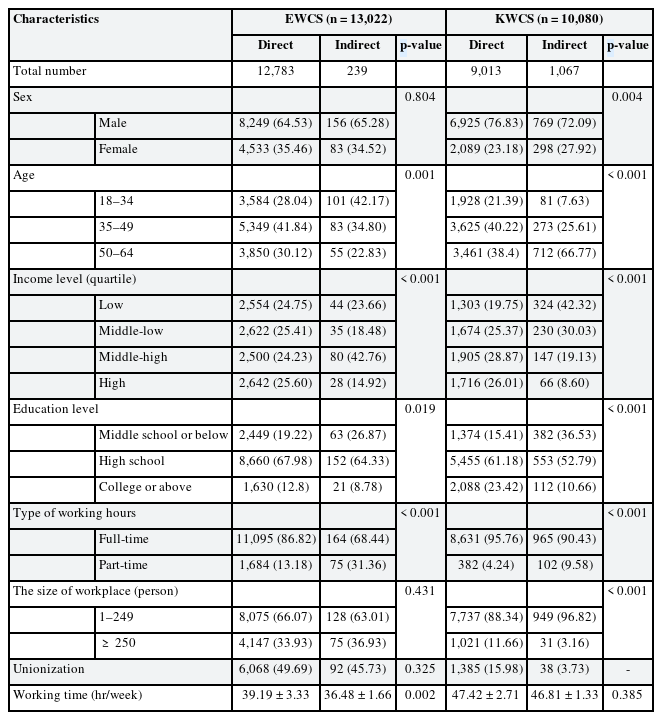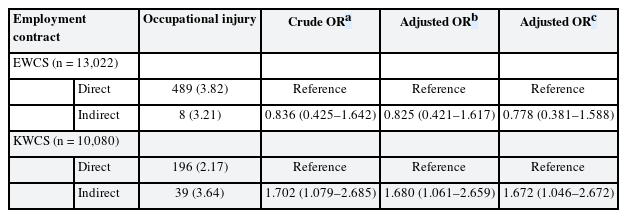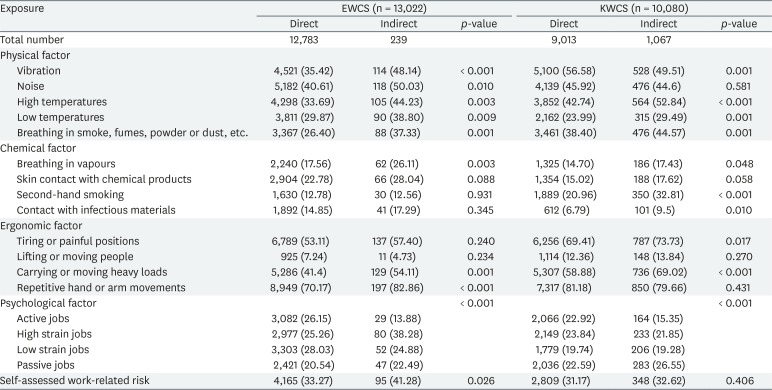Comparison of work environment and occupational injury in direct and indirect employment in Korea and Europe
Article information
Abstract
Background
To investigate the risk of injury for indirect employment in Korea, we compared work environment, workplace exposure, and injury risk according to the type of employment contract between Korea and European Union (EU) countries.
Methods
We analyzed data of blue-collar workers from the fourth Korean Working Conditions Survey (2014) and the sixth European Working Conditions Survey (2015) and compared workplace risk factors and preventive factors for occupational injuries. Multiple logistic regression analysis was conducted to identify the relationship between occupational injury and the type of employment contract after adjusting for age and sex.
Results
For descriptive characteristics, a relatively older age, lower income, lower proportion of full-time work, greater proportion in small-sized companies, and fewer unionizations were noted in indirect employment in Korea than in direct employment. Workplace exposure was significantly higher in indirect employment in both Korea and Europe. Among safety-related factors, indirect employment in both Korea and Europe lacked the support of company education, coworkers, and supervisors. Indirectly employed blue-collar workers had a significantly higher risk of occupational injury than those directly employed in Korea (odds ratio [OR]: 1.876), whereas there was no significant difference between directly and indirectly employed workers in EU countries (OR: 1.038).
Conclusions
Indirectly employed blue-collar workers have an increased risk of occupational injury in Korea.
INTRODUCTION
One of the main issues in the area of occupational health research is workers' health inequality according to employment contract [123]. The definition of multiparty employment, according to an International Labour Organization report is “Not direct, subordinate relationship with end user” and is characterized by a triangular employment relationship including the worker, the agency (the contracting company), and the client (the company). The term used for the work in multiparty employment is expressed in various ways. It is mainly referred to as “temporary agency work” in Europe, whereas it is referred to as “labor brokerage” and “labor hire” in Africa, and “labor dispatch” in Asian countries. In Korea, multiparty employment is called “indirect employment” because workers are employed through a third party, which includes “labor dispatch” and “subcontracting.”
Outsourcing has created many problems in Korea recently, and social concern has increased. Occupational injuries are a risk to workers' health and at the same time have an economic impact [4]. According to recent data, indirect employment in Korea is estimated at 3.46 million, accounting for 17.4% of the total number of wage workers [5]. Indirect employment is low not only in wages and welfare but also in the health and safety area, which is closely related to worker fatalities, suggesting a problem with this indirect employment system [6]. Nevertheless, there is still a shortage of medical and public health studies that directly deal with this issue [67].
To accurately investigate the risk of injury for workers under indirect employment conditions in Korea, we focused on blue-collar workers because they are more likely to experience occupational injuries than workers in other industries [8]. In order to understand the problem of indirect employment in Korea, we analyzed such data in comparison with Europe. In this way, we compared the working environment and exposure, and investigated the causes of occupational injury according to employment contract. Considering that the results could be different for every country [8], we compared the status according to employment contract between Korea and Europe.
METHODS
Study participants
The current study used data from the fourth Korean Working Conditions Survey (KWCS) in 2014 and the sixth European Working Conditions Survey (EWCS) in 2015. The KWCS and EWCS are nationally recognized surveys and include questions regarding the occupational environment, socioeconomics, and workers' health conditions [910]. The KWCS benchmarked the EWCS, creating a number of comparison studies of working environments in Europe and Korea [1112].
The source population was 50,007 in the 2014 KWCS and 43,850 in the 2015 EWCS. Among these populations, we defined the eligible populations as wage workers and blue-collar workers (such as craft workers, assemblers, plant and machine operators, and elementary workers) aged 19 to 64 years. We excluded nonpaid workers (n = 19,254 in the KWCS, n = 12,900 in the EWCS), non-blue-collar workers (n = 20,239 in the KWCS, n = 18,120 in the EWCS), and workers aged < 18 or ≥ 65 (n = 1,725 in the KWCS, n = 227 in the EWCS) (Fig. 1). After excluding participants with no information on employment contract records, history of occupational injury, age, or sex (n = 188 in the KWCS, n = 268 in the EWCS), the final samples analyzed were 8,599 participants in the KWCS and 12,335 participants in the EWCS.
Variable measurement
In this study, the employment contract was an independent variable, and the employment contract records were verified through KWCS and EWCS. In the KWCS, direct or indirect employment contracts were identified using the question “Did you receive wages from the workplace, dispatch company, or service company?” If participants answered “workplace,” it was defined as direct employment. In the same way, indirect employment was defined in Korea if participants answered “dispatch company” or “service company.” In the EWCS, if participants answered “contract of unlimited duration” or “contract of limited duration” to the question “What kind of employment contract do you have in your main job?” it was defined as direct employment. If participants answered “temporary employment agency contract” to the same question, it was defined as indirect employment. In addition, if participants answered, “Paid a salary or a wage by an agency” to the question “Please select category or categories which apply to your main paid job,” it was defined as indirect employment.
In this study, occupational injury was a dependent variable. In the KWCS and EWCS, there were questions about self-reported health problems over the past 12 months. Among them, there was a question about occupational injury.
The sociodemographic variables included sex, age, educational level, and income, and this information was collected in the questionnaire. Age was categorized as 18–34, 35–49, or 50–64 years. Educational level was classified as follows according to the International Standard Classification of Education (ISCED): less than middle school (ISCED 0–2); high school (ISCED 3, 4); and college or more (ISCED 5 or more). The net monthly income of all participants was divided into 4 quartiles: low, middle-low, middle-high, and high.
Occupational variables included employment contract status, type of working hours, workplace size, the feasibility of unionization, and weekly working hours, using the KWCS and EWCS. We divided the workplace size into 250 people or fewer, based on the numbers of workers in the workplace. In Korea, the general reference unit for the workplace size is 300 people; however, the EWCS does not have such a reference unit. Thus, we instead used the 250-person criterion used in the EWCS.
We also compared occupational exposure to possible threat according to employment contract in both Europe and Korea. The exposure variables included physical, chemical, biological, ergonomic, and psychological factors in the workplace, and a self-assessment regarding workplace risks. For the physical, chemical, biological, and ergonomic factors, answers were chosen on a 7-point Likert scale: 1) all of the time; 2) almost all of the time; 3) around 3/4 of the time; 4) around half of the time; 5) around 1/4 of the time; 6) almost never; and 7) never. When 1–5 was selected, exposure was classified as present, whereas when 6–7 was selected, exposure was classified as not present.
Job demand and job control were measured as psychological factors. As with previous KWCS and EWCS papers, the participants' answers to job demand and control questions were scored and divided into low and high based on the median value [1314]. According to Robert Karasek, job demand and control were classified as 4 job stress categories: low-strain job (low demand, high control); passive job (low demand, low control); high-strain job (high demand, low control); and active job (high demand, high control).
Safety practices, training, and support in the workplace were also examined in our study. Safety practices included “Using protective equipment when it is required” and “Receiving the health and safety risks information of your job.” The question about training was “Over the past 12 months, have you undergone any of the following types of training to improve your skills or not?” There were 2 items related to training: “Training provided by the company” and “On-the-job training” were divided into 2 responses, “yes” or “no,” separately. Additionally, we investigated “Feedback on the work from the supervisor/manager.” The items for support were divided into 2 categories depending on the participant: “Help and support from colleagues” or “Help and support from the supervisor/manager.”
Statistical analysis
KWCS and EWCS data were analyzed separately to compare Korean and European participants. When we compared the characteristics of the indirect employment workers (case group) and the direct employment workers (control group), we used χ2 tests and t-tests for the categorical variables and continuous variables, respectively. We conducted simple and multiple logistic regression analyses with occupational injury as the outcome variable and employment contracts (indirect versus direct employment) as the explanatory variable. We used sociodemographics (age, sex) and work-related factors (Korean Standard Classification Occupation, time of working hour, the size of workplace) as covariates. Income could also be considered as a covariate, but in our study, we treated income as a mediator [15]. The mediator is part of the mechanism by which explanatory variables influence outcome variables. When adjusting the mediator, the influence of the independent variable can be underestimated. Therefore, we did not adjust income as a covariate.
Participants with missing data regarding employment contract, and the covariates age and sex, were deleted in advance. For the variables except for sex, age, and employment contract, some participants had missing values, but the participants were not previously deleted, and when the percentage or mean of each variable was calculated, the value was deleted if it was missing. We conducted the statistical analysis using SAS software (version 9.4; SAS Institute, Cary, NC, USA). By utilizing functions proc surveyfreq and proc surveylogistic from the SAS 9.4 program and taking weighted values into account, statistical analysis was executed. We applied weighted analyses in this study and show the weighted number of people and the proportion (%) as well as p-value.
RESULTS
Missing values
As mentioned in the Methods section, there were some participants' missing values in Tables 1, 2, 3. When the percentages or means were calculated, the values were deleted if they were missing (Supplementary Table 1).
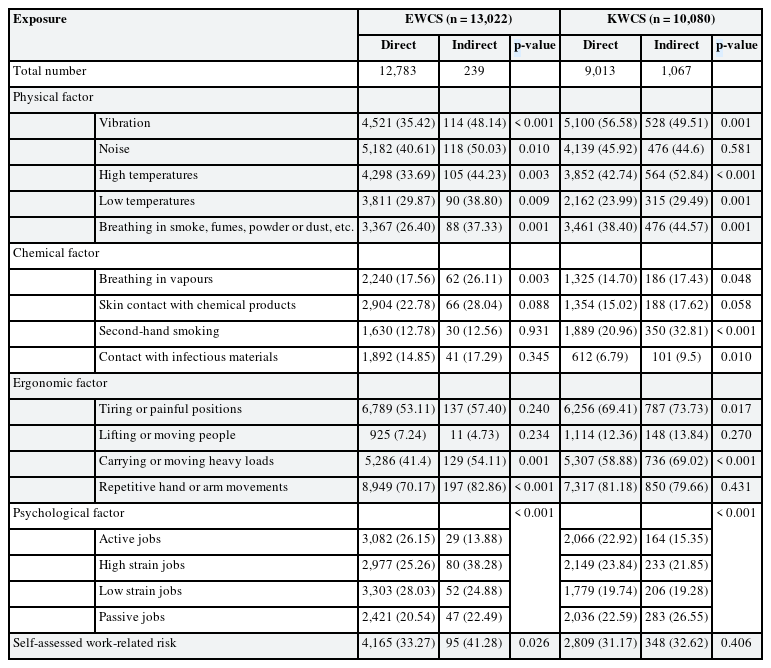
Exposure to physical, chemical, biological, ergonomic risk factors, psychological factors, self-assessed work-related risks and mistreating experience in workplace
Socioeconomic status and occupational environment according to employment contract
Table 1 shows the socioeconomic status and occupational environment according to employment contract records in Korea and Europe. The main difference with Europe is that indirect employment in Korea showed a relatively older age, lower income, and lower rate of unionization. In indirect employment, Korea and Europe showed different patterns of population distribution. Indirect employment in Europe was mainly distributed between the ages of 19 and 34, whereas indirect employment in Korea was mainly distributed between the ages of 50 and 64. In both Korea and Europe, direct employment was evenly distributed from the low to high quartile of income. However, unlike Europe, indirect employment in Korea was concentrated in the low- and middle-low income quartile. In Europe, unionization was relatively high, without differences between direct or indirect employment. However, in Korea as a whole, unionization was low; and between them, indirect employment showed a significantly lower rate than direct employment. As for the working schedule, indirect employment in Europe had a relatively low rate of full-time workers and relatively short weekly work hours. On the other hand, indirect employment in Korea was not significantly different from direct employment in the percentage of full-time workers and weekly work hours.
Occupational exposure in the workplace according to employment contract
The results of the chi-squared analysis between employment contracts and occupational exposure are shown in Table 2. In terms of physical, chemical, and ergonomic factors, indirect employment workers in both Korea and Europe were more exposed to occupational hazards, except for vibration in Korea. Considering the psychological factors, the ratio of active jobs, the suitable type among the 4 categories of the job demand control model for job stress, was relatively less in indirect employment in both Korea and Europe. Instead, indirect employment workers were mainly distributed in high-strain jobs with high-stress risk or passive jobs without intrinsic motivation. The self-assessment of work-related risks were similar in Korea, but not in Europe.
Workplace safety practices, training, and support at workplace according to employment contract
Table 3 shows workplace safety practices, training, and support according to employment contract in Korea and Europe. Among these, the common problems of indirect employment in both Korea and Europe were the low amount of training provided by the company, help and support from colleagues, and help and support from the supervisor/manager. Unlike Europe, the problems of indirect employment in Korea were on-the-job training, and work feedback from the supervisor/manager. However, the problem of indirect employment in Europe was the low rate of receiving the health and safety risk information for their job.
Risk of occupational injury according to employment contract
We estimated the prevalence and risk for occupational injury according to employment contract through odds ratios (ORs) (Table 4). The prevalence of occupational injury in indirect employment (3.66%) was estimated at 1.8 times greater than the injury in direct employment (1.99%) in Korea. However, both indirect and direct employment had a similar prevalence in Europe. There was a significantly higher risk of occupational injury for indirect employment in Korea (adjusted OR: 1.876; 95% confidence interval [CI]: 1.259–2.724), whereas this was not the case in Europe (adjusted OR: 1.038; 95% CI: 0.511–1.868).
DISCUSSION
In our study, indirectly employed blue-collar workers showed dangerous working environment compared with those directly employed in both Korea and Europe. However, indirectly employed blue-collar workers in Korea showed more relatively vulnerable situations and higher risk of occupational injury.
In previous studies, occupational injuries related to nonstandard employment contracts have been a major issue. However, due to the heterogeneity of nonstandard workers, results varied by the target industries and countries [16]. According to a recent systemic review article [16], 10 of the 17 reviewed studies reported a positive association between precarious employment and occupational injuries. Four studies reported a negative association, whereas 3 studies did not show any significant association. Among these, all indirect employment-related studies showed significant positive associations. These results were consistent in Italy, Finland, Sweden, and the United States [8171819]. In Korea, occupational injury in indirect employment has received much attention due to recent accidents. Two studies have reported on the damage of indirect employment in Korea. One of them only focused on subcontracting in indirect employment [7]. The study showed that subcontracted workers had a higher risk of work-related diseases, injury, and absenteeism than parent firm workers. The other study did not break down workers' compensation claims by the type of injury or disease [6]. Thus, differences in the results of injury or disease between direct employment and indirect employment were diluted and showed no significant difference.
In previous studies, factors and mechanisms associated with occupational injury were known as socioeconomic inequalities [2021], workplace exposure [7], and working environment (unionization [16], inexperience and lack of safety training at the workplace [22]). Our study had factors that are only significant for indirect employment in Korea in comparison with factors in Europe. First are the socioeconomic factors, such as low income and an older age. The higher the socioeconomic status, the better the response to health problems and the injuries. Socioeconomic factors are known to affect injury risk through a complex process [21]. Among the reasons for injuries deriving from socioeconomic discrimination are psychosocial factors, such as stress from poverty. Those with low socioeconomic status also live in an environment that is relatively more vulnerable to injury.
Second, indirect employment in Korea consists of a high percentage of older workers, unlike Europe (Table 1). A high proportion of aged workers in indirect employment can also be a cause of occupational injury [23]. The problem of unemployment in Korea continues, but general timing of retirement is relatively early in life. In this situation, aged workers compete with young workers for employment. As a result, aged workers are easily employed as indirect workers, given they are relatively less attractive to employers and are less competitive [23]. The aged worker is a risk factor for occupational injury, and the working environment of indirect employment is riskier; thus, aged indirect employment workers can be placed in a more dangerous environment.
Other problematic factors of indirect employment in the working environment in Korea and not in Europe include working hours, the size of the workplace, and unionization. First, temporary workers can sometimes work longer hours. It is known that the risk of injury is increased when working over 60 hours per week [24]. A relatively high proportion of workers exceeding 60 hours could be a factor in the indirect employment risk in Korea. Second, workplace size is also a typical risk factor [25]. Small-sized companies have limited resources for prevention of injury and often try to reduce safety measures to reduce production costs. Technologically, small firms adopt methodologies that imply a substantial man-machine. Third, unionization is a factor that reduces the risk of injury. Unions can help prevent hazards in the workplace. Employees at unionized workplaces are better informed of their rights, and union leaders demand safety measures be implemented by the company [16]. Fourth, inexperience and lack of safety training in the workplace are important risk factors for occupational injury. However, indirect employment in Korea is significantly different from direct employment in terms of on-the-job training and work feedback from the supervisor (Table 3). Indirect employment is highly flexible; therefore, it is more likely to be associated with job insecurity than fixed-term contracts. Lack of clarity regarding employer responsibility, high turnover of assignments, and continual changes of workplace can also have negative consequences on safety and health in indirect employment [19]. Such on-the-job training is an important component of job-related injuries and therefore has a significant impact on the risk of injury [25]. Due to the lack of such training and feedback, the proportion of careless or reckless behaviors can also increase the risk of injury [26].
The strength of our study is that by using similar surveys between Europe and Korea, we were able to compare occupational character and injury risk of indirect employment between Asian and European countries. However, our study has some limitations. Because it is a cross-sectional study, there is a disadvantage in that causal relationships are difficult to determine. A longitudinal study would be needed in the future. Also, our data were from self-reported questionnaires without medical records. Another limitation is that the comparison between direct and indirect employment was not made among workers in the same company. Finally, the sociocultural contexts of Europe and Korea are different; thus, it is necessary to consider this issue when making direct comparisons.
CONCLUSIONS
Indirect employment workers in both Korea and Europe are more frequently exposed to occupational hazard than direct employment workers. The results of our study showed an association between occupational injury and indirect employment contract, particularly in Korea. Indirect employment has increased risks of occupational injury, which is closely related to fatal situations, suggesting a problem with the indirect employment system. It is necessary to devote attention to the prevention of various occupational injuries among indirect employment workers, and improvement to the system that emphasizes the responsibility of the parent firm is needed.
ACKNOWLEDGEMENTS
The author wants to express appreciation to Korea Occupational Safety and Health Agency (KOSHA) & Eurofound because of its offering the raw data of the fourth Korean Working Conditions Survey & sixth European Working Conditions Survey.
Notes
Competing interests: The authors declare that they have no competing interests.
Author Contributions:
Conceptualization: Kang MY, Cho SS.
Data curation: Ahn J.
Formal analysis: Ahn J.
Funding acquisition: Cho SS.
Investigation: Ahn J.
Methodology: Kang MY, Ahn J.
Software: Ahn J.
Supervision: Kang MY.
Validation: Kang MY, Ahn J.
Writing - original draft: Ahn J.
Writing - review & editing: Kang MY, Cho SS, Kim HR, Myong JP, Ahn J.
Abbreviations
CI
confidence interval
Direct
direct employment
EU
European Union
EWCS
European Working Conditions Survey
Indirect
indirect employment
ISCED
International Standard Classification of Education
KWCS
Korean Working Conditions Survey
OR
odds ratio
References
SUPPLEMENTARY MATERIAL
Supplementary Table 1
Missing values of every variable

